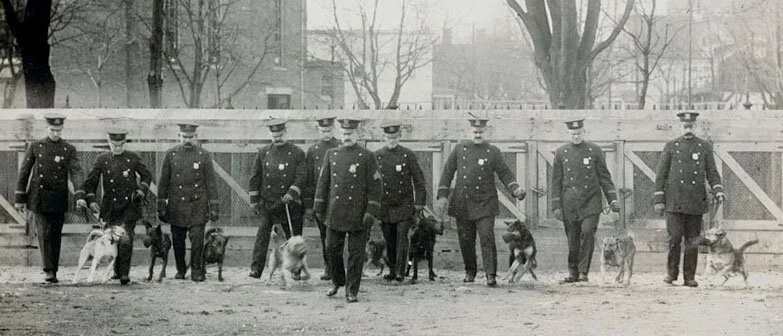Law enforcement agencies use man’s best friend to assist in a variety of tasks; to not only make their jobs easier, but to make them safer. Many of those tasks require a honed set of skills taught by professional dog trainers, which take months to master. The tasks are created for a specific dog breed; for example, not all breeds are considered for take-down maneuvers, based on size or general temperament. Imagine a Chihuahua or Pekingese attempting to tackle a perp. However, such breeds are excellent choices to sniff out explosives, drugs, or fit into small areas. All in all, K-9 units have developed for more than a hundred years, and some of those procedures and techniques haven’t changed much, even those that originated in Europe.
The earliest K-9 training facility started in Ghent, Belgium, in 1899, which became widely recognized as the leader in canine training, utilizing Belgian sheepdogs and wolfhounds. As a result, word spread and in 1907, Brigadier General Theodore A. Bingham, the New York (NY) Police Commissioner, sent Inspector George R. Wakefield to study Ghent’s training program. Wakefield returned to the states with five Belgian sheepdogs for operation and breeding purposes. This would become the first canine training program implemented in the United States but met only moderate success. The New York Police Department decided to adopt the Ghent police dog training program, rather than develop their own. After all, they were trained by the best. By 1911, 16 dogs were trained – with their respective handlers, as required by the Ghent training program – and sent out to various residential areas in Long Island between 11 pm and 7 am every day. Results were mixed at best. The dogs were trained to chase and tackle anyone between these times, stand on their chests, and bark until their handlers arrived. [1]
From the time they were puppies, the NYPD raised them in closed off areas away from the public and only allowed them a set amount of time with civilians. They were trained not only to obey law enforcement in general, but to see anyone not in a police uniform as hostile. During training, men would walk through the kennels in plain clothes and tease the dogs for several days or even weeks until the dogs showed extreme aggressiveness towards anyone not wearing a uniform. Tackling was another matter. Dogs were trained to wrap their front paws around the lower legs and drag them down. Additionally, dogs were trained to search houses, track, and chase suspects. These procedures were carried over from the Ghent training program. The NYPD wasn’t the only agency to adopt these training methods. In 1910, Glen Ridge, New Jersey, purchased two Belgian sheepdogs from the NYPD to patrol vacant homes and the streets. However, by 1918, they disbanded the K-9 unit as the patrol car had made them nearly obsolete – and due to the number of complaints by civilians who chose to take late-night strolls. [2]
Dogs were used more unofficially between the 1920s and 1940s, mostly by the military and occasional private agencies. Not until the end of the war, after seeing the successful use of dogs during the Second World War in England and by private organizations, did American law enforcement make another attempt at implementing them again. [3]
The early to mid-1950s saw a surge in K-9 training programs, but most were by private companies for security purposes, such as large department stores. This changed in 1954, when the Dearborn (MI) Police Department hired an ex-marine dog trainer to train four German shepherds to perform patrol duties. Four patrolmen volunteered as handlers and received six months of training. The dogs were trained to scale walls, enter a vehicle and hold its occupants, disarm a man, search buildings, and be vicious or gentle on command. After six months on patrol, not a single police dog-related incident was reported, and as a result, the corps was disbanded. In 1955, the dogs were sold to the Portland (OR) Police Bureau to begin their own canine corps. [4]
Even after purchasing five more German shepherds and six doberman pinschers, the Portland canine corps was deemed unsuccessful and disbanded. This was partially to do with the change of handlers – a key component of a K-9 unit is the bond between canine and handler. Another reason was the lack of training the dogs received. There was an incident of a dog attacking a detective who was pulling a suspect out from underneath a vehicle. Other incidents showed the dogs couldn’t locate suspects in an open field or warehouse because they were trained not in tracking but in quartering, like hunting dogs. Additionally, though, the high cost of kenneling, transporting, and general care of the canine corps meant basic upkeep was impossible. Portland police officials stated that the program could have been successful with “… more manpower and equipment,” but at the moment, the “dogs were a liability rather than an asset.” [5]
In 1956, the Baltimore City (MD) Police Department instituted the first modern canine corps in the United States. During the same time, the Los Angeles (CA) Police Department attempted to do the same and saw the many benefits of having a canine corps but had few areas that required foot patrols. Given the widespread use of motor vehicle patrols, the LAPD didn’t see how the costs could outweigh the rewards. However, Baltimore’s program was so successful that it garnered attention across the United States, prompting nearby police departments to request specialized training to create their own K-9 units. After visiting the Baltimore training facility in 1959, the Lancaster (PA) Police Department had five volunteer handlers ready for service. [6]
Current Day – The Spotsylvania (VA) Sheriff’s Department
The National Law Enforcement Museum has an exhibit on the training and implementation of police dogs, types of breeds used for specific tasks, and some of the science behind how they are trained to execute these tasks. On display is a cast molding of K-9 Dux and his handler Deputy Kory Kelley of the Spotsylvania County (VA) Sheriff’s Department. The Museum chose Dux and Deputy Kelley for this exhibit after an incident on the night of October 2, 2016, after a traffic stop went awry. The suspect escaped custody and left the scene on foot. Deputy Kelley warned the fleeing suspect twice that he would release K-9 Dux, but he continued to run. Dux was just feet from the suspect, when he turned around and shot twice, striking Dux in the back and neck. He then took aim at Deputy Kelley and fired two more shots, missing both times. Deputy Kelley fired four shots in return, striking the suspect in the leg. K-9 Dux was rushed to the hospital and made a full recovery. Read more about the October 2, 2016 incident. More recently, on the night of August 11, Deputy Kelley and K-9 Dux spoiled an attempted robbery by a man who broke into a Spotsylvania business. No one was injured during the incident and the man was taken into custody. Read more about the August 11, 2019 incident.
Deputy Kelley and K-9 Dux are one of five K-9 teams with the sheriff’s department, which began training dogs in 1976. The canine breeds vary and include Labrador retrievers, German shepherds, Belgian malinois, and bloodhounds. K-9 Dux is a purebred German shepherd from Belgium. Each dog is trained to respond to certain circumstances, but all receive rigorous training throughout the year, so they are always ready when called upon. Of the five, three are trained in narcotics and explosives detection, one in search and rescue, and one in narcotics. In addition to their recertification tests, each team is required to complete 16 hours a month of on-going training.
The Spotsylvania (VA) Sheriff’s Department speaks highly of their K-9 unit:
The canines help us do our job safer and faster saving the Sheriff’s Office hundreds of man-hours every year. The canines freely and willingly go into areas deputies are not able to. We rely on the canine teams to use their special abilities to help us locate suspects, evidence, narcotics, explosives, or missing persons quickly. [7]
America has seen the use of canines in law enforcement for more than 100 years; with failures and successes, but one aspect has remained, and that is the continued use of man’s best friend remaining an integral part – and partner – to law enforcement professionals.
If you’d like to see what K-9 Dux is up to, then check out his Facebook page here.
Cited Sources
[1] Handy, William F., Marilyn Harrington, and David J. Pittman. “The K-9 Corps: The Use of Dogs in Police Work,” The Journal of Criminal Law, Criminology, and Police Science 52, no. 3 (September 1961): 328.
[2] Ibid, 328-30.
[3] Ibid, 333.
[4] Ibid, 333.
[5] Ibid, 333.
[6] “Police Employ Dogs to Help Keep the Peace,” American City and County, last modified July 23, 2012. https://www.americancityandcounty.com/2012/07/23/police-employ-dogs-to-help-keep-the-peace/.
[7] “K-9,” Spotsylvania Sheriff. http://www.spotsylvaniasheriff.org/divisions/patrol/k-9/.
Additional sources about K9 history and training:
http://www.tarheelcanine.com/wp-content/uploads/2017/10/Bite-Progression.pdf
https://www.perrosdebusqueda.es/wp-content/uploads/2014/11/Libro-Police-dogs.pdf
https://scholarlycommons.law.northwestern.edu/cgi/viewcontent.cgi?article=5041&context=jclc
For more information about the National Law Enforcement Officers Memorial Fund, please visit lawmemorial.org. For more information about the National Law Enforcement Museum, please visit lawenforcementmuseum.org.


